Ragtime, also spelled rag-time or rag time, is a musical style that had its peak from the 1890s to 1910s. Its cardinal trait is its syncopated or "ragged" rhythm. Ragtime was popularized during the early 20th century by composers such as Scott Joplin, James Scott and Joseph Lamb. Ragtime pieces are typically composed for and performed on piano, though the genre has been adapted for a variety of instruments and styles.

Scott Joplin was an American composer and pianist. Dubbed the "King of Ragtime", he composed more than 40 ragtime pieces, one ragtime ballet, and two operas. One of his first and most popular pieces, the "Maple Leaf Rag", became the genre's first and most influential hit, later being recognized as the quintessential rag. Joplin considered ragtime to be a form of classical music meant to be played in concert halls and largely disdained the performance of ragtime as honky tonk music most common in saloons.
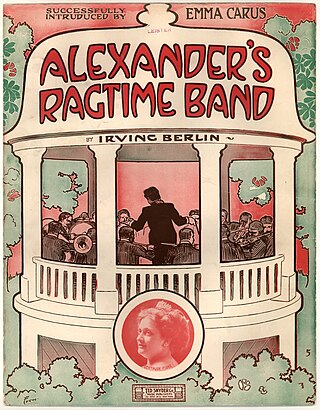
"Alexander's Ragtime Band" is a Tin Pan Alley song by American composer Irving Berlin released in 1911; it is often inaccurately cited as his first global hit. Despite its title, the song is a march as opposed to a rag and contains little syncopation. The song is a narrative sequel to Berlin's earlier 1910 composition "Alexander and His Clarinet". This earlier composition recounts the reconciliation between an African-American musician named Alexander Adams and his flame Eliza Johnson as well as highlights Alexander's innovative musical style. Berlin's friend Jack Alexander, a cornet-playing African-American bandleader, inspired the title character.
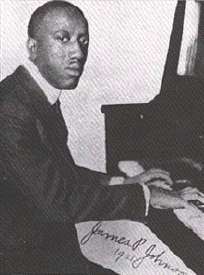
James Price Johnson was an American pianist and composer. A pioneer of stride piano, he was one of the most important pianists in the early era of recording, and like Jelly Roll Morton, one of the key figures in the evolution of ragtime into what was eventually called jazz. Johnson was a major influence on Count Basie, Duke Ellington, Art Tatum, Thelonious Monk, and Fats Waller, who was his student.
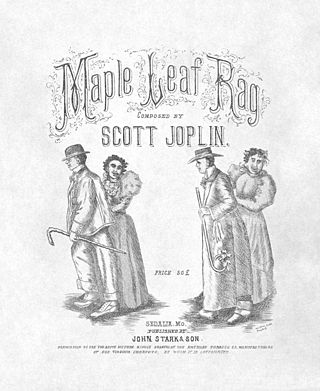
The "Maple Leaf Rag" is an early ragtime musical composition for piano composed by Scott Joplin. It was one of Joplin's early works, and became the model for ragtime compositions by subsequent composers. It is one of the most famous of all ragtime pieces. As a result, Joplin became dubbed the "King of Ragtime" by his contemporaries. The piece gave Joplin a steady if unspectacular income for the rest of his life.
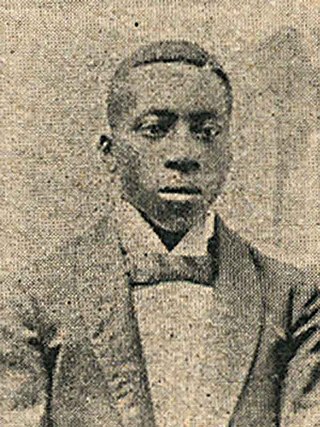
Arthur Owen Marshall was an American composer and performer of ragtime music from Missouri. He was a protege of famed ragtime composer Scott Joplin.

Classic rag is the style of ragtime composition pioneered by Scott Joplin and the Missouri school of ragtime composers. These compositions were first considered "classic" by Joplin's publisher, John Stark, as a way to distinguish them from what he considered the "common" rags of other publishers. Today, any composition fitting this particular ragtime structural form is considered classic rag.

Treemonisha (1911) is an opera by American ragtime composer Scott Joplin. It is sometimes referred to as a "ragtime opera", though Joplin did not refer to it as such and it encompasses a wide range of musical styles. The music of Treemonisha includes an overture and prelude, along with various recitatives, choruses, small ensemble pieces, a ballet, and a few arias.

"The Entertainer" is a 1902 classic piano rag written by Scott Joplin.

The "Swipesy Cakewalk" is a ragtime composition written in 1900 by a musical duo consisting of Scott Joplin, who composed the trio, and the young composer Arthur Marshall, who composed the rest of the piece. "Swipesy" uses the simple syncopations of a cakewalk - the first beat being a sixteenth, eighth, sixteenth note division, and the second beat an even eighth note division. The style follows the AA BB A CC DD musical form common for both cakewalks and rags, particularly after the earlier publication of Joplin's hit "Maple Leaf Rag". Only the C section, composed by Joplin, departs from the cakewalk rhythm and is more pure ragtime. The composition was written in the late 1890s when Joplin was living with the Marshall family, and was teaching Arthur, composition.

"Magnetic Rag" is a 1914 ragtime piano composition by American composer Scott Joplin. It is significant for being the last rag which Joplin published in his lifetime, three years before his death in 1917. It is also unique in form and in some of the musical techniques employed in the composition.

"That Mysterious Rag" is a song by Irving Berlin and Ted Snyder written in 1911. It was one of the earliest Berlin songs to become a commercial success with recordings by Arthur Collins & Albert Campbell and by the American Quartet being very popular in 1912.

"Bethena, A Concert Waltz" is a composition by Scott Joplin. It was the first Joplin work since his wife Freddie's death on September 10, 1904, of pneumonia, ten weeks after their wedding. At the time the composer had significant financial problems; the work did not sell successfully at the time of publication and was soon neglected and forgotten. It was rediscovered as a result of the Joplin revival in the 1970s and has received acclaim from Joplin's biographers and other critics. The piece combines two different styles of music, the classical waltz and the rag, and has been seen as demonstrating Joplin's excellence as a classical composer. The work has been described as "an enchantingly beautiful piece that is among the greatest of Ragtime Waltzes", a "masterpiece", and "Joplin's finest waltz".
Trebor Jay Tichenor was a recognized authority on Scott Joplin and the ragtime era. He collected and published others' ragtime piano compositions and composed his own. He authored books about ragtime, and both on his own and as a member of The St. Louis Ragtimers, became a widely known ragtime pianist.
Julius Weiss was a German-born American Jewish music professor, best known for being the first piano teacher of Scott Joplin, who became known as "the king of ragtime".
Max Edward Morath was an American ragtime pianist, composer, actor, and author. He was best known for his piano playing and is referred to as "Mr. Ragtime". He was a touring performer as well as being variously a composer, recording artist, actor, playwright, and radio and television presenter. Rudi Blesh billed Morath as a "one-man ragtime army".

"Elite Syncopations" is a 1902 ragtime piano composition by American composer Scott Joplin, originally published in 1903 by John Stark & Son. The cover of the original sheet music prominently features a well-dressed man and lady sitting on a treble staff, looking down upon a cherub clutching a cymbal in each hand, which reflects plainly the title of the piece. In 1974, the British Royal Ballet, under director Kenneth MacMillan, created the ballet Elite Syncopations based on tunes by Joplin and other composers of the era.
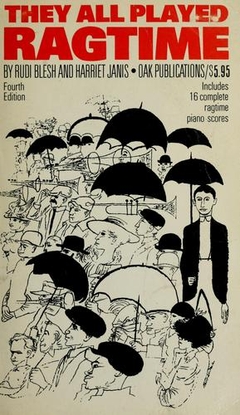
They All Played Ragtime is a non-fiction book by journalist Rudi Blesh and author Harriet Janis, originally published by Grove Press in 1950. It was subsequently reissued in 1959, 1966, and 1971 by Oak Publications, and in 2007 by Nelson Press. According to the Preface to the Fourth Edition, by Rudi Blesh, the book was conceived and researched largely by Harriet Janis, who died in 1963. It is generally recognized as the pioneering and first serious book to document the history and major composers of ragtime in America, and has been referred to as The Bible of Ragtime.
Glenn Jenks was an American ragtime pianist, composer and music historian.














